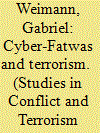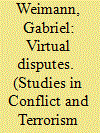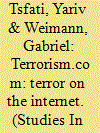|
|
|
Sort Order |
|
|
|
Items / Page
|
|
|
|
|
|
|
| Srl | Item |
| 1 |
ID:
107644


|
|
|
|
|
| Publication |
2011.
|
| Summary/Abstract |
In 1989, the term fatwa became globally known, following Ayatollah Khomeini's death-fatwa issued on Salman Rushdie for his novel, Satanic Verses. Today, the Internet has become a useful platform for posting of fatwas and interpretations of fatwas. The present article highlights the use of jihadist fatwas, and especially online fatwas, as a major instrument in bridging the current wave of terrorism and religion. The analysis, based on a database collected in a 12-year-long project of monitoring thousands of terrorist websites, illustrates how cyber-fatwas are related to key issues in promoting terrorism: justifying the use of suicide terrorism, the killing of innocents, the killing of children and women, the killing of Muslims or the use of various weapons (including weapons of mass destruction and cyberterrorism). There are two implications of the trends documented in this study: First, the analysis of the online fatwas and the fatwa wars may provide insight about the terrorists, their motivations, their doubts and fears and, secondly, it may guide countercampaigns.
|
|
|
|
|
|
|
|
|
|
|
|
|
|
|
|
| 2 |
ID:
060660


|
|
|
|
|
| Publication |
Mar-Apr 2005.
|
| Summary/Abstract |
Cyberterrorism conjures up images of vicious terrorists unleashing catastrophic attacks against computer networks, wreaking havoc, and paralyzing nations. This is a frightening scenario, but how likely is it to occur? Could terrorists cripple critical military, financial, and service computer systems? This article charts the rise of cyberangst and examines the evidence cited by those who predict imminent catastrophe. Psychological, political, and economic forces have combined to promote the fear of cyberterrorism. From a psychological perspective, two of the greatest fears of modern time are combined in the term “cyberterrorism.” The fear of random, violent victimization segues well with the distrust and outright fear of computer technology. Many of these fears, the report contends, are exaggerated: not a single case of cyberterrorism has yet been recorded, hackers are regularly mistaken for terrorists, and cyberdefenses are more robust than is commonly supposed. Even so, the potential threat is undeniable and seems likely to increase, making it all the more important to address the danger without inflating or manipulating it.
|
|
|
|
|
|
|
|
|
|
|
|
|
|
|
|
| 3 |
ID:
094844


|
|
|
|
|
| Publication |
2010.
|
| Summary/Abstract |
Given the growth of Internet research in recent years, it is rather surprising that research of online terrorism and countermeasures has been lacking theoretical and conceptual frameworks. The present study suggests applying the concepts and models taken from e-marketing to the study of terrorist websites. This work proves that when Hamas builds an array of sites in the Internet, it complies with the same rules that the Western business world follows. Chaffey et al. (2000) constructed a model comprised of eight decision points in the process of building a business-oriented Internet site. Although the model was developed for commercial purposes, the present study demonstrates how it could be used as an analytic framework to study terrorist websites. As shown, most of the decision points in the model were relevant to the Palestinian Information Center group of websites. Understanding the e-marketing strategy of Hamas will allow the construction of a competing marketing strategy in order to market rival ideological consumer products.
|
|
|
|
|
|
|
|
|
|
|
|
|
|
|
|
| 4 |
ID:
144870


|
|
|
|
|
| Summary/Abstract |
The terms Deep Web, Deep Net, Invisible Web, or Dark Web refer to the content on the World Wide Web that is not indexed by standard search engines. One can describe the Internet as composed of layers: the “upper” layer, or the Surface Web, can easily be accessed by regular searches. However, “deeper” layers, the content of the Deep Web, have not been indexed by traditional search engines such as Google. Michael K. Bergman who wrote the seminal paper on the Deep Web, compared searching the Internet to dragging a net across the surface of the ocean: a great deal may be caught in the net, but there is a wealth of information that is deeper and therefore missed. In fact, most of the Web's information is buried far down on sites, and standard search engines are unable to access it.
|
|
|
|
|
|
|
|
|
|
|
|
|
|
|
|
| 5 |
ID:
191473


|
|
|
|
|
| Summary/Abstract |
TikTok is the fastest-growing application today, attracting a huge audience of 1.5 billion active users, mostly children and teenagers. Recently, the growing presence of extremist’s groups on social media platforms became more prominent and massive. Yet, while most of the scholarly attention focused on leading platforms like Twitter, Facebook or Instagram, the extremist immigration to other platforms like TikTok went unnoticed. This study is a first attempt to find the Far-right’s use of TikTok: it is a descriptive analysis based on a systematic content analysis of TikTok videos, posted in early 2020. Our findings reveal the disturbing presence of Far-right extremism in videos, commentary, symbols and pictures included in TikTok’s postings. While similar concerns were with regard to other social platforms, TikTok has unique features to make it more troublesome. First, unlike all other social media TikTok’ s users are almost all young children, who are more naïve and gullible when it comes to malicious contents. Second, TikTok is the youngest platform thus severely lagging behind its rivals, who have had more time to grapple with how to protect their users from disturbing and harmful contents. Yet, TikTok should have learned from these other platforms’ experiences and apply TikTok’s own Terms of Service that does not allow postings that are deliberately designed to provoke or antagonize people, or are intended to harass, harm, hurt, scare, distress, embarrass or upset people or include threats of physical violence.
|
|
|
|
|
|
|
|
|
|
|
|
|
|
|
|
| 6 |
ID:
103793


|
|
|
|
|
| Publication |
2011.
|
| Summary/Abstract |
The current age of technology, mass communication, and globalization makes networks analysis an especially useful tool for understanding cell-based terrorism. Some concepts from traditional networks analysis may be especially relevant. The Strength of Weak Ties hypothesis (SWT) is particularly promising and will be used here to demonstrate the usability of traditional networks analysis for studying modern terrorism. The findings suggest that the strength of weak terrorist ties may improve Al Qaeda's operational capabilities despite the group's decentralization following the U.S.-led military campaign in Afghanistan beginning in 2001.
|
|
|
|
|
|
|
|
|
|
|
|
|
|
|
|
| 7 |
ID:
078302


|
|
|
|
|
| Publication |
Washington, DC, United States Institute of Peace Press, 2006.
|
| Description |
xv, 309p.
|
| Standard Number |
9781929223718
|
|
|
|
|
|
|
|
|
|
|
|
Copies: C:1/I:0,R:0,Q:0
Circulation
| Accession# | Call# | Current Location | Status | Policy | Location |
| 052453 | 363.325/WEI 052453 | Main | On Shelf | General | |
|
|
|
|
| 8 |
ID:
075043


|
|
|
|
|
| Publication |
2006.
|
| Summary/Abstract |
Terrorists are using the Internet for various purposes. Most of the attempts to monitor and study terrorist presence on the Net focused on the practical and communicative uses of this channel by modern terrorists. Yet, not much attention has been paid to the use of the Net as a medium for terrorist debates and disputes. This descriptive article presents this less noticed facet of terrorism on the Net by providing examples of virtual debates among and within terrorist groups. The analysis of the online controversies, disputes, and debates may say a lot about the mindsets of terrorists, their motivations, their doubts and fears. In many ways, it allows the researcher to open a window to a world about which so little is known. It may also serve counterterrorism: by learning the inner cleavages and debates one can find practical ways to support the voices against terror, to broaden gaps within these dangerous communities, and to channel the discourse to nonviolent forms of action.
|
|
|
|
|
|
|
|
|
|
|
|
|
|
|
|
| 9 |
ID:
186052


|
|
|
|
|
| Summary/Abstract |
What began as the 1972 Munich Olympic Games quickly became a global media event, a live broadcast of a deadly terrorist attack that changed the future of modern terrorism. Broadcast to an audience of over 900 million, the event was a game changer that changed the relationships within the triangle terrorism-media-public. The ‘new’ terrorism, following the Munich massacre, has adapted the new rules of the game, the rules of media-oriented actions. Media-oriented terrorism is the use of pre-planned attacks that are wittingly designed to get media attention and coverage and consequently to reach the general public and decision makers. This article presents two powerful concepts in communication and terrorism paradigm that emerged from this tragic event: the notion of The Theatre of Terror and the notion of Coercive Media Events. Finally, it examines post-Munich trends and especially how terrorists’ migration to social media and online platforms has preserved and refined their lessons from the Munich attack.
|
|
|
|
|
|
|
|
|
|
|
|
|
|
|
|
| 10 |
ID:
022728


|
|
|
|
|
| Publication |
2002.
|
| Description |
317-332
|
|
|
|
|
|
|
|
|
|
|
|
|
|
|
|
|
|
|
|
|